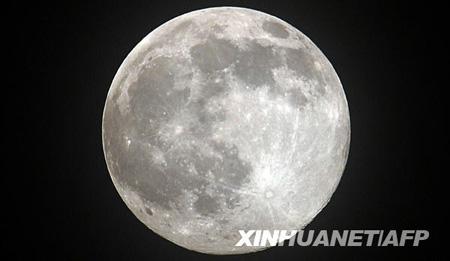U.S. lunar probe finds water on moon
2009-11-14 08:07 BJT
WASHINGTON, Nov. 13 (Xinhua) -- Preliminary data from the Lunar Crater Observation and Sensing Satellite, or LCROSS, indicated that the mission had successfully uncovered water during the Oct. 9 impacts into the permanently shadowed region of Cabeus crater near the moon's south pole, NASA said on Friday in a press release.
 |
| Preliminary data from the Lunar Crater Observation and Sensing Satellite, or LCROSS, indicated that the mission had successfully uncovered water during the Oct. 9 impacts into the permanently shadowed region of Cabeus crater near the moon's south pole, NASA said on Friday in a press release. |
"We're unlocking the mysteries of our nearest neighbor and by extension the solar system. It turns out the moon harbors many secrets, and LCROSS has added a new layer to our understanding," said Michael Wargo, chief lunar scientist at NASA Headquarters in Washington.
NASA successfully crashed two spacecraft into the moon's south pole in a hunt for hidden ice on Oct. 9.
A 2.2-ton Centaur, the upper stage of the Atlas V rocket that carried LCROSS into space, struck the Cabeus crater first at around 5,600 miles (9,000 kilometers) per hour. Four minutes later, the LCROSS, which was equipped with cameras to record the impact, hit the Cabeus crater.
According to NASA, the impact created by the LCROSS Centaur upper stage rocket created a two-part plume of material from the bottom of the crater. The first part was a high angle plume of vapor and fine dust and the second a lower angle ejecta curtain of heavier material. This material has not seen sunlight in billions of years.
Scientists have long speculated about the source of vast quantities of hydrogen that has been observed at the lunar poles. The LCROSS findings are shedding new light on the question of water, which could be more widespread and in greater quantity than previously suspected.
Permanently shadowed regions could hold a key to the history and evolution of the solar system, much as an ice core sample taken on Earth reveals ancient data. In addition, water and other compounds represent potential resources that could sustain future lunar exploration.
Since the impacts, the LCROSS science team has been working almost nonstop analyzing the huge amount of data the spacecraft collected. The team concentrated on data from the satellite's spectrometers, which provide the most definitive information about the presence of water. A spectrometer examines light emitted or absorbed by materials that helps identify their composition.
Related stories
- Water found on the moon 2009-11-09
- Back to the moon effort moves ahead 2009-10-29
- NASA delays moon rocket test flight due to bad weather 2009-10-28
- NASA: Moon strike not total waste of time 2009-10-19
- NASA looks for water on the moon 2009-10-10

 Mail
Mail Share
Share Print
Print


 Video
Video









 2009 China Central Television. All Rights Reserved
2009 China Central Television. All Rights Reserved